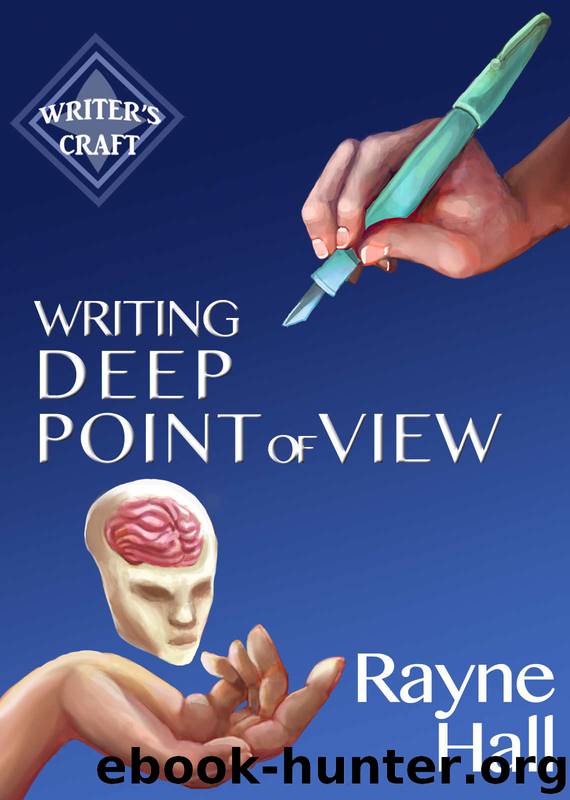Writing Deep Point of View by Rayne Hall

Author:Rayne Hall [Hall, Rayne]
Language: eng
Format: epub
ISBN: 9781519231758
Published: 2015-10-21T04:00:00+00:00
Chapter 14
BODY LANGUAGE
If you’re used to writing fiction in omniscient (god-like, all-seeing) or shallow PoV, you may have to unlearn some habits.
SHOW ONLY WHAT THE POV SEES, HEARS, FEELS
Show the PoV character’s body language only if she can see or feel it. Let’s say Mary feels embarrassed, and she blushes.
Mary’s cheeks reddened.
This would jolt the reader out of the PoV, because Mary can’t see her own face go red.
Mary’s cheeks heated.
This sentence stays in Mary’s experience, because she can feel her face grow hot.
Avoid any kind of body language the PoV character can’t see, hear or feel, such as these:
Mary’s face paled.
Mary’s eyes widened.
Mary’s eyes glistened with tears.
The colour drained from Mary’s face.
With practice, you’ll soon get the hang of this.
SHOW ONLY WHAT THE POV IS AWARE OF
Show the PoV character’s body language only if she is aware of it.
Many body language cues, especially gestures, movements and posture shifts could be seen by the character—but she wouldn’t be aware of them in this particular situation. If she’s not aware of them, leave them out, otherwise the PoV becomes shallow.
Let’s say Mary watches her lover in a fight to the death in the arena. Her anxiety and tension are extreme, and she perches on the edge of a stone bench, leaning forward, with the knuckles of both fists pressed against her chin.
You may want to show her anxiety and tension with this sentence:
Mary perched on the edge of the stone bench, leaning forward, with the knuckles of both fists pressed against her chin.
This is a good sentence—but it’s not Deep PoV. Hypothetically, Mary could be aware that she’s sitting like this—but not when her full attention is on her lover’s fight. Mary is so focused on the action in the arena, she won’t waste a thought on the position of her buttocks on the bench.
Most body language is unintentional. It just happens, and we’re not aware of it. This means that you can’t use it in deep PoV. For newcomers to Deep PoV, this restriction poses a major challenge.
Of course, you can still use body language. You just need to choose carefully what to show and in what situation.
HOW TO USE BODY LANGUAGE IN DEEP POV
Show the PoV’s body language if she can see, hear or feel it.
This includes visceral reactions.
Sweat trickled down Mary’s sides.
Mary’s cheeks heated.
Mary’s throat tightened.
Mary’s words came out as a hoarse whisper.
Careful: don’t give detailed descriptions of these visceral reactions unless the PoV character dwells on the sensation.
Show body language when the PoV character is using it deliberately.
Mary squared her shoulders and raised her chin.
Mary leaped from the chair and slammed her fist on the table.
Mary stomped out of the room, banging the door behind her.
Of course, you can show the other characters’ body language—and indeed, you may use a lot of it. More about this in the next chapter.
ASSIGNMENT
Consider a scene draft you’ve written, or a scene you’re planning to write. What are the PoV’s feelings during this scene? How does the PoV’s body language
Download
This site does not store any files on its server. We only index and link to content provided by other sites. Please contact the content providers to delete copyright contents if any and email us, we'll remove relevant links or contents immediately.
And Here's the Kicker: Conversations with 21 Top Humor Writers on Their Craft by Mike Sacks(1068)
2024-2120 by Russell Fine(884)
2120-2126 by Russell Fine(883)
Letters to a young poet by Rainer Maria Rilke(742)
You Should Be Writing by Brenda Knight & Brenda Knight(726)
550 AP Calculus AB & BC Practice Questions by Princeton Review(709)
How Tell a Story and Other Essays by Mark Twain(693)
Reading for the Plot by Peter Brooks(682)
Poetics (Penguin Classics) by Aristotle(655)
Improve Your Writing with NLP by Judith Pearson(619)
Cultures and Beyond (The Art of World Building Book 3) by Randy Ellefson(618)
Letters to a Young Poet (Rediscovered Books) by Rainer Maria Rilke(604)
The Story Works Guide to Writing Point of View: How to harness the power of POV and write amazing narratives. (The Story Works Guide to Writing Fiction Book 2) by Winternheimer Alida(595)
Odessa Stories by Isaac Babel(586)
The Hidden Writer by Alexandra Johnson(573)
Confident Digital Content by Adam Waters(565)
Story Structure Architect by Schmidt Victoria Lynn(562)
Mastering the Process by Elizabeth George(561)
The George Sand-Gustave Flaubert Letters by George Sand & Gustave Flaubert(558)
